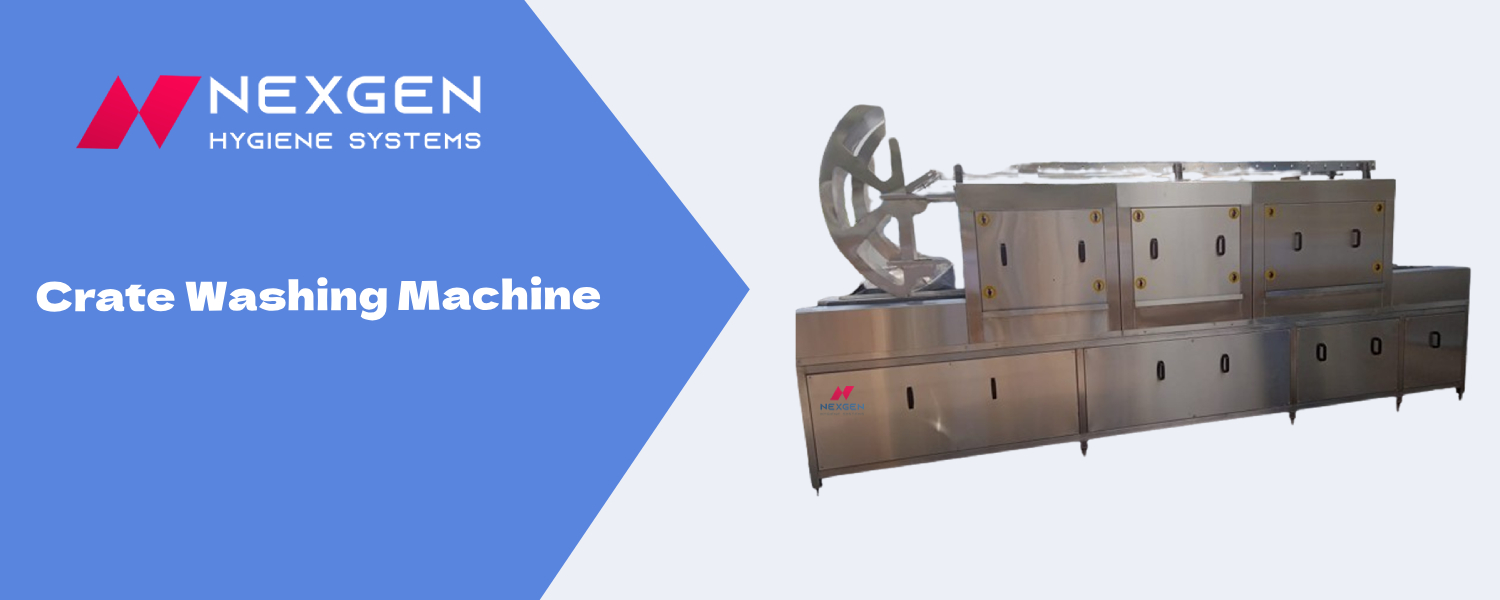Crates are essential in food processing, agriculture, cold storage, pharmaceuticals, and chemical facilities. But dirty crates? They’re a hygiene liability and a resource drain. One crate carrying raw milk, vegetables, or packaged meds can become a contamination source if not properly cleaned.
That brings us to a critical decision many facilities face:
Is manual crate washing costing you more than you think? Should you upgrade to a mechanized crate washing machine?
What Manual Crate Washing Really Looks Like

Walk into any small-scale food or agri facility, and you’ll see it: buckets, scrubbing brushes, a few workers standing knee-deep in water, manually washing crates. This method might have worked when the load was light and hygiene expectations were lower.
But today, the picture is different:
- Production volumes are higher
- Water costs have shot up
- Audits and hygiene regulations are stricter
Manual washing:
- Consumes 10–15 litres of water per crate
- Takes about 3–5 minutes per crate
- Depends entirely on the worker’s skill and focus
- Leaves room for inconsistent cleaning or chemical residue
That’s a lot of risk and cost for something so routine.
The Shift Toward Mechanized Crate Washing
Modern crate washing systems, like those offered by Nexgen food processing equipment, replace scrubbing and guesswork with pressure-controlled cleaning and structured rinsing.
While these machines still require loading and oversight, they take over the most intensive part: the actual washing process.
Here’s what this means for you:
Consistent Results, Every Time
Mechanized crate washing systems use:
- High-pressure nozzles to dislodge food, dirt, and chemical residue
- Filtered recirculating water to reduce waste
- Controlled detergent use for better cleaning without overuse
No fatigue. No missed spots. Just uniform cleaning, crate after crate.
Time Saved on Every Batch
Let’s run the math:
- A team of two workers manually cleaning 300 crates may take 6–8 hours.
- A mechanized system with pressure jets and a crate guide system can clean 200–500 crates per hour.
The difference? What used to take all day now takes a few hours with one operator.
Significant Water Savings
One of the biggest advantages of switching from manual to machine-assisted crate washing is water control.
Manual washing is wasteful-hoses left running, rinsing repeated, detergent overused.
Mechanized systems:
- Use targeted jets for maximum impact
- Include recirculation systems to reuse clean water
- Reduce water consumption by up to 70–80% per cycle
For facilities watching water usage or located in regions facing restrictions, this change matters.
Safer, Audit-Ready Hygiene Standards
If your plant is inspected under FSSAI, HACCP, GMP, or ISO frameworks, random crate cleaning won’t cut it.
Mechanized crate washers help:
- Standardize cleaning across batches
- Reduce dependency on manual intervention
- Prepare your facility for hygiene audits without scrambling
That’s especially relevant in:
- Dairy units handling raw milk crates
- Food processing units moving ready-to-eat or packed items
- Pharma warehouses storing bulk packaging and primary materials
- Cosmetic units with high cleanroom expectations
Comparing Manual and Machine-Based Crate Washing
| Feature | Manual Washing | Mechanized Crate Washing |
|---|---|---|
| Cleaning Time | 3-5 min per crate | 3-5 seconds per crate |
| Water Use | 10-15 L per crate | 2-4 L per crate |
| Labour Requirement | 2-3 workers full-time | 1 operator |
| Cleaning Quality | Inconsistent | Uniform and pressure-based |
| Compliance Readiness | Low | High |
Where This Matters the Most
Dairy Plants
Milk residue is stubborn. Unclean crates can breed bacteria fast. You need consistent pressure cleaning-not guesswork.
Cold Storage & Beverage Units
Thousands of crates come and go daily. Manual cleaning can’t keep up with turnaround times. A machine simplifies scheduling and reduces labour costs.
Agricultural Packaging
Fresh produce often arrives dirty, with soil, leaves, and pesticide traces. Pressure-based washing helps prep crates for the next cycle faster and safer.
Pharmaceutical & Cosmetic Facilities
Hygiene breaches here can mean product rejection or recall. Mechanized washing aligns better with your cleanroom standards.
So… Is It Worth It?
If you process more than 150–200 crates per day, a machine makes more financial and operational sense—especially when you look at:
- Water bills
- Labour costs
- Missed dispatches due to slow washing
- Failed hygiene audits
Nexgen, one of India’s trusted industrial kitchen equipment manufacturers, offers crate washers designed for real-world food processing and hygiene demands. Their machines are built for high throughput, made from stainless steel, and designed with Indian operating conditions in mind.
Whether you run a dairy, agri-packaging unit, distribution center, or pharma warehouse—this switch pays off in 6 to 12 months.
FAQs
How many crates can a crate washer process in an hour?
Depending on model and soil load, most units handle 200-500 crates/hour.
Is the machine suitable for dairy or milk residue?
Yes. High-pressure jets effectively clean off dairy film and organic build-up.
Does it require special detergent?
No, but using food-grade, low-foam cleaning agents is recommended for best results.
Can this machine clean different crate sizes?
Yes. Adjustable guides and nozzle configurations accommodate various crate types.
How much water does it save compared to manual washing?
On average, 60-80% less water is used due to recirculation and targeted spraying.
Do I need a separate drying machine?
Some models include an air knife drying system. You can also add a separate drying unit.
Is it hard to maintain?
Not really. Basic weekly cleaning and monthly checks keep it running smoothly.
